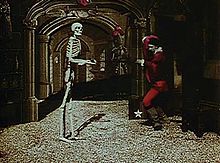The Haunted Castle (1897 French film)
| The Haunted Castle | |
|---|---|
 A frame from the film | |
| Directed by | Georges Méliès |
Release date | 1897 |
Running time | Short |
| Country | France |
| Language | Silent film |
Le Château hanté, released in the United States as The Devil's Castle and in Britain as The Haunted Castle, is an 1897 French short silent film directed by Georges Méliès.[1] The film is about a man who enters a haunted castle and is constantly taunted by spirits inside the castle.
Plot
Two men enter a room in a castle; one offers a chair to the other, and then exits. The remaining man attempts to sit down, but the chair moves away from him and he falls to the ground. When the man approaches the chair, it turns first into a ghost, then a skeleton, and then an armored knight; then it disappears completely. Turning, the man finds himself confronted by Satan. He attempts to escape, but his way is blocked by a ghost.
Production and release
The film marks the second appearance of Satan as a character in a Méliès film (the first was Le Manoir du diable the previous year).[2] The special effects in the film were created using the editing technique known as the substitution splice.[3] One moment in the film, the transformation of the ghostly figure into a knight in armor, prefigures numerous sight gags involving armor that became popular during the silent era in comedy films.[4]
Le Château hanté was released by Méliès's Star Film Company and is numbered 96 in its catalogues.[1] The English film pioneer George Albert Smith, a corresponding friend and colleague of Méliès, was among the buyers of the film; Smith himself experimented extensively with similarly ghostly topics in his own films made around the same time.[5]
The film was the first Méliès work to be hand-colored at the coloring lab run by Elisabeth Thuillier.[6] A hand-colored print of Le Château hanté survives; its straightforward color scheme uses a red tone to help the characters stand out from the painted backdrop (although the tones also help distract the eye from the editing tricks used).[3] Méliès went on to have Thuillier and her lab workers hand-color many of his films; later collaborations between Méliès and Thuillier were much more elaborate in their use of color.[3]
See also
References
- ^ a b Malthête, Jacques; Mannoni, Laurent (2008), L'oeuvre de Georges Méliès, Paris: Éditions de La Martinière, p. 337, ISBN 9782732437323
- ^ Malthête, Jacques (1992), "Méphisto-Méliès et les thèmes religieux chers à Pathé", in Cosandey, Roland (ed.), Une invention du diable?: cinéma des premiers temps et religion, Sainte-Foy: Presses de l'Univ. Laval, pp. 223–9
- ^ a b c Yumibe, Joshua (2012), Moving Color: Early Film, Mass Culture, Modernism, New Brunswick, NJ: Rutgers University Press, pp. 71–2
- ^ Balducci, Anthony (2012), The Funny Parts: A History of Film Comedy Routines and Gags, Jefferson, NC: McFarland, p. 237
- ^ Jones, David J. (2011), Gothic Machine: Textualities, Pre-Cinematic Media and Film in Popular Visual Culture, 1670–1910 (ebook edition), Cardiff: University of Wales Press, p. 184
- ^ Frazer, John (1979), Artificially Arranged Scenes: The Films of Georges Méliès, Boston: G. K. Hall & Co., p. 150, ISBN 0-8161-8368-6
